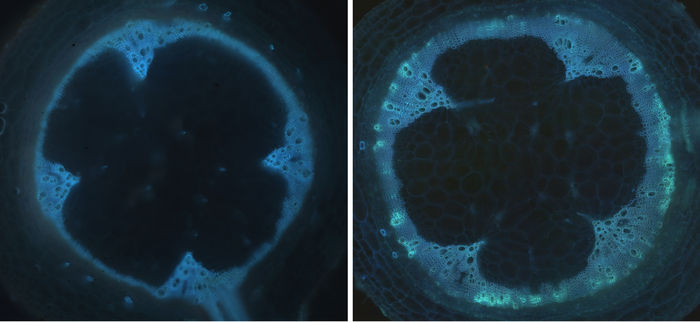A wall to stop bacterial wilt
Researchers unveils the physico-chemical nature of the xylem barriers responsible for bacterial wilt resistance in tomato plants
Advertisement
A new work led by Núria Sánchez Coll, CSIC researcher at the Centre for Research in Agricultural Genomics (CRAG), elucidates how tomato plant varieties resistant to the bacterial wilt pathogen Ralstonia solanacearum have the ability to restrict bacterial movement in the plant. The study, published in New Phytologist, analyses the composition and formation of the xylem barriers that confer resistance to R. solanacearum, a soil bacterium with devastating effects on many solanaceous crops such as tomato, potato, pepper and eggplant. Results have allowed researchers to engineer resistance to R. solanacearum in commercial susceptible varieties of tomato plants.

Cross-sections of tomato plant stems observed with fluorescence microscopy from susceptible (left) and resistant (right) tomato plant varieties infected with Ralstonia solanacearum. Resistant plants show an accumulation of phenolic compounds (blue fluorescence) and ligno-suberin-related compounds (green fluorescence) at their vasculature that provide a restriction mechanism against the bacterium.
Centre for Research in Agricultural Genomics (CRAG)
The agro-economic impact of R. solanacearum, the pathogen responsible for the bacterial wilt disease, preoccupies farmers all over the world due to the large number of species it affects, its broad geographical distribution, and its persistence in soil and water. This pathogen enters the plant through the roots and colonizes the xylem vessels that carry water and nutrients to the stems and leaves, spreading systemically and eventually killing the plant. Tomato plant varieties resistant to bacterial wilt are able to synthesize reinforcement coatings that confine R. solanacearum into infected vessels, preventing bacterial spread to healthy tissues. Despite being a key factor of resistance, the composition and formation of these barriers had not been studied in detail until now.
Wall reinforcements to confine the infection
In order to understand how bacterial wilt resistance works, researchers compared a susceptible commercial tomato plant variety with a highly resistant tomato cultivar which, despite producing very small fruits unfit for consumption, contributes a reliable source of resistance in breeding programmes. After infecting both varieties with R. solanacearum, histological, live-imaging and spectroscopic analysis revealed the formation of vascular coatings containing ligno-suberin and related phenolic compounds (such as HCAAs) in resistant plants. Such structural wall reinforcements, which were not present in susceptible plants, provide a physico-chemical barrier that confines the bacteria into the xylem and makes its vessels resilient to pathogenic degradation.
Engineering tomato resistance to bacterial wilt
In line with the observed accumulation of ligno-suberin and related compounds in vascular coatings, further analysis showed that the genes involved in the synthesis pathways of these molecules were overexpressed in resistant plants infected with R. solanacearum. Based on these results, researchers set to determine whether overexpressing such genes in susceptible tomato plants would increase their resistance to bacterial wilt.
Original publication
Anurag Kashyap, Álvaro Luis Jiménez-Jiménez, Weiqi Zhang, Montserrat Capellades, Sumithra Srinivasan, Anna Laromaine, Olga Serra, Mercè Figueras, Jorge Rencoret, Ana Gutiérrez, Marc Valls and Nuria S. Coll.; "Induced ligno-suberin vascular coating and tyramine-derived hydroxycinnamic acid amides restrict Ralstonia solanacearum colonization in resistant tomato."; New Phytologist (2022).























































